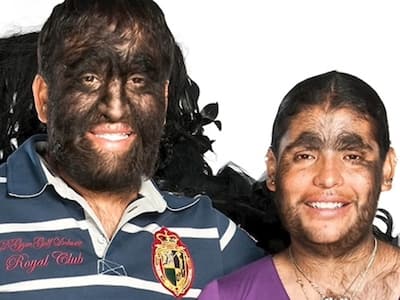
Victor, Gabriel, Luisa and Jesus are four of a 'family of 19 that span five generations', all with the rare congenital generalized hypertrichosis condition that is characterised by 'excessive facial and torso hair'.
Imagine being a part of a family that makes history and finds a spot in the Guinness Book of World Records for being...hairy! A video shared by the official social media handle of Guinness showed members of a family, apparently in Mexico, whose faces are covered with abnormal amounts of hair. Touted to be the 'largest hairy family', Victor 'Larry' Gomez, Gabriel 'Danny' Ramos Gomez, Luisa Lilia De Lira Aceves and Jesus Manuel Fajardo Aceves are members of a family that suffers from a rare condition called 'congenital generalized hypertrichosis'.
What Is Congenital Generalized Hypertrichosis?
According to rarediseases.org, X-linked congenital generalized hypertrichosis is a rare congenital (present at birth) skin disease that is characterised by hair overgrowth on the entire body in males, and mild and asymmetric hair overgrowth in females. It is associated with mild facial abnormalities (like nasal openings tipped upwards and moderate protrusion of the jaw) and occasional teeth anomalies and deafness. Also known as 'werewolf syndrome', it is caused by a specific abnormality of the X chromosome. Inheritance of this condition is X-linked. It is important to know if the disease occurs alone (is an isolated form), or if it is part of a genetic syndrome.
What Does Its Treatment Look Like?
Treatment of this condition includes standard methods for hair removal like shaving, laser hair removal, electrolysis, chemical methods and others, states rarediseases.org.
Also Read
- Regular Cleansing And Conditioning: Know Why It's Important For Healthy Hair
- Teenager With The Longest Hair In The World Does This To Maintain It...
- Guinness Recognition: Meet Rumeysa Gelgi, World's Tallest Woman With The Longest Ears
More News
View this post on InstagramA post shared by Guinness World Records (@guinnessworldrecords)
The Hairy Family
According to Guinness, Victor, Gabriel, Luisa and Jesus are four of a 'family of 19 that span five generations', all with the rare congenital generalized hypertrichosis condition that is characterised by 'excessive facial and torso hair'. While the women are covered with a 'light-to-medium coat of hair', the men of the family have 'thick hair on approximately 98 per cent of their body', apart from their hands and feet.
Apparently, Larry and Danny perform in the Mexican National Circus, and all the members of the family have assisted scientists with the analysis of the gene responsible for this condition. As a result, 'significant evidence' was found for 'linkage with several markers from the long arm of the X chromosome'.
Historical Documentation
According to the Italian Journal of Pediatrics, individuals affected by hypertrichosis have been recorded since the Middle Age and the Renaissance. "At that time and in the following centuries, interest was limited to their 'characteristic phenotype', and they were often 'exhibited as unnatural phenomena' in circuses and fairs due to their peculiar aspect," it states.
Normal Hair Growth Versus Hypertrichosis
In addition to that, it is important to note that in any 'normal individual', hair follicles are 'enclosed in the skin with the exception of the palms, soles, and lips'. In hypertrichosis, there is an 'excessive growth in body hair beyond the normal variation compared with individuals of the same age, race and sex and affecting areas not predominantly androgen-dependent'.
The term 'hirsutism', for instance, is usually reserved for patients -- mainly female -- who show extensive hair growth in androgen-dependent areas and with male pattern distribution, the Italian Journal of Pediatrics states, adding that the clinical pattern of hypertrichosis can vary in individuals, ranging from 'lanugo' to 'vellous' and 'terminal' hairs.
- Lanugo refers to 'long and unmedullated hairs'.
- Vellous hairs are 'unmedullated, short, soft and lightly pigmented', and seen on the face of infants.
- Terminal hairs are produced by follicles and appear 'medullated, dense and varying in length' depending on the area.




































